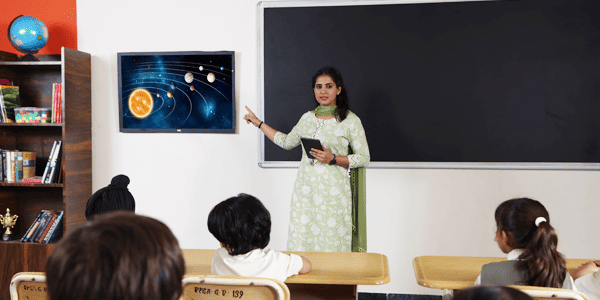Boost Your Child’s Confidence with Primary Science Tuition Singapore
Boost Your Child’s Confidence with Primary Science Tuition Singapore
Blog Article
A Comprehensive Overview to the Various Knowing Approaches in Primary Science Guideline
The expedition of varied discovering approaches in key science direction presents a chance for teachers to improve trainee interaction and comprehension significantly. By analyzing hands-on knowing techniques, inquiry-based techniques, and joint methods, we can identify efficient methods that cater to different discovering designs.

Hands-On Learning Methods
Hands-on discovering methods play a crucial role in primary science guideline, involving trainees in energetic expedition and experimentation. These methods enable learners to communicate straight with products and sensations, promoting a much deeper understanding of scientific ideas. By utilizing manipulatives, designs, and real-life experiments, teachers create an environment where students can observe, hypothesize, and test their concepts.
Such strategies not just improve comprehension however likewise grow critical reasoning and analytic abilities. When pupils participate in activities like building simple machines, planting seeds, or conducting chain reactions, they are encouraged to ask concerns and seek answers with their own monitorings. This experiential strategy assists to demystify complex clinical concepts, making them much more easily accessible and relatable.
Additionally, hands-on learning promotes cooperation among peers, as students frequently operate in teams to conduct experiments or share findings. This teamwork not just enhances their knowing experience but additionally establishes vital social skills. Inevitably, incorporating hands-on strategies in primary scientific research guideline promotes a lifelong love of understanding and inquisitiveness regarding the natural world, laying a strong foundation for future scholastic quests in science and past.
Inquiry-Based Understanding
Inquiry-based discovering is a training approach that urges trainees to ask questions, explore phenomena, and create their own understanding of clinical ideas. This technique moves the focus from conventional teacher-led instruction to an extra student-centered experience, where learners take the initiative in their instructional trip. By promoting curiosity, inquiry-based learning advertises much deeper interaction with the material, permitting trainees to discover topics in a meaningful context.
In method, this strategy commonly involves hands-on experiments, observations, and critical reasoning tasks that line up very closely with the scientific approach. Students are urged to formulate theories, design examinations, and assess data, which cultivates necessary abilities such as logical and problem-solving reasoning. The function of the instructor in this framework is to help with exploration, leading pupils through the query procedure while encouraging independent thought and collaboration.
Furthermore, inquiry-based knowing nurtures a sense of ownership over the knowing process, motivating students to pursue knowledge proactively. This approach not just boosts understanding of clinical principles yet additionally cultivates a long-lasting love for learning, gearing up trainees with the abilities necessary to navigate a progressively complicated globe.
Collaborative Learning Approaches
Collective discovering techniques equip trainees to take part in purposeful communications with peers, promoting a shared obligation for their educational results. In main science direction, these techniques motivate learners to work together to explore scientific concepts, solve problems, and carry out experiments (primary science tuition Singapore). By taking part in group activities, students can utilize diverse viewpoints, permitting richer understanding and retention of scientific understanding
One key facet of collaborative knowing is the focus on communication abilities. Students need to articulate their thoughts, pay attention actively to others, and discuss concepts, all of which are important competencies in both scholastic and real-world contexts. This social interaction not only boosts their understanding of clinical principles however additionally promotes team effort my latest blog post and problem resolution skills.
When students see the value of their contributions within a team, they are much more likely to take ownership of their learning trip. On the whole, integrating joint learning methods in key science direction grows a dynamic discovering setting that prepares trainees for future scholastic and social challenges.
Innovation Combination in Science
The assimilation of modern technology in main science guideline improves learning experiences by providing cutting-edge tools and sources that sustain various training methodologies, including joint knowing - primary science tuition Singapore. Making use of electronic platforms, simulations, and interactive applications permits trainees to engage deeply with clinical ideas, helping with an extra hands-on technique to knowing
Digital labs, for instance, allow learners to carry out experiments safely and effectively, promoting inquiry-based understanding. These tools can imitate real-world scientific circumstances, allowing trainees to visualize complicated procedures that would be hard to duplicate in a typical classroom setup. Furthermore, innovation cultivates communication and cooperation among trainees, as they can share searchings for and interact on projects with on-line platforms.
Furthermore, multimedia discussions and instructional video clips can enrich lessons by accommodating diverse understanding designs, making abstract concepts much more easily accessible. Information evaluation devices also empower students to gather and translate clinical information, enhancing vital believing abilities. On the whole, the tactical consolidation of innovation in main science direction not just improves interaction however likewise prepares trainees for a highly innovative culture, outfitting them with crucial abilities for future clinical undertakings.
Set Apart Instruction Strategies
Distinguished direction methods are necessary for resolving the varied needs of learners in primary science education and learning. These strategies enable educators to tailor their teaching methods to accommodate varying abilities, passions, and learning designs within the class. By utilizing distinguished direction, teachers can create a comprehensive setting that promotes interaction and enhances understanding of clinical ideas.
One efficient technique is to use adaptable organizing, which enables students to collaborate with peers at comparable skill levels visit the site or with varying point of views. This method encourages peer learning and advertises vital thinking. Additionally, supplying options in projects can encourage trainees, permitting them to pick jobs that reverberate with their rate of interests while still meeting curricular purposes.
Additionally, incorporating tiered jobs is an additional important strategy. Deliberately tasks with differing levels of intricacy, educators can make certain that all trainees are appropriately challenged, no matter their efficiency. Utilizing developmental analyses to assess understanding more enables educators to adjust their training techniques dynamically, guaranteeing that each student receives the assistance they need.
Inevitably, carrying out differentiated direction approaches in key science education and learning not only boosts student knowing results yet also cultivates an interest for science, preparing students for future academic quests.

Final Thought
In summary, reliable primary science guideline necessitates a diverse strategy that includes hands-on understanding, inquiry-based methods, and collective strategies. The integration of innovation and set apart instruction even more provides to varied knowing styles, cultivating a setting conducive to exploration and important thinking.
The exploration of diverse discovering approaches in primary science guideline presents a chance for instructors to boost pupil engagement and comprehension dramatically.Hands-on learning techniques play a critical function in main scientific research guideline, involving trainees in energetic read exploration and testing.Inquiry-based discovering is a training technique that motivates trainees to ask concerns, examine phenomena, and construct their own understanding of scientific principles.Joint understanding strategies encourage trainees to engage in meaningful interactions with peers, cultivating a common duty for their academic results. In general, incorporating collaborative understanding approaches in key scientific research guideline grows a dynamic learning setting that prepares pupils for future academic and social challenges.
Report this page